Turtles are one of those exotic pets that everyone wants to own. As a result, you can find turtles for sale in just about every pet store and animal shelter.
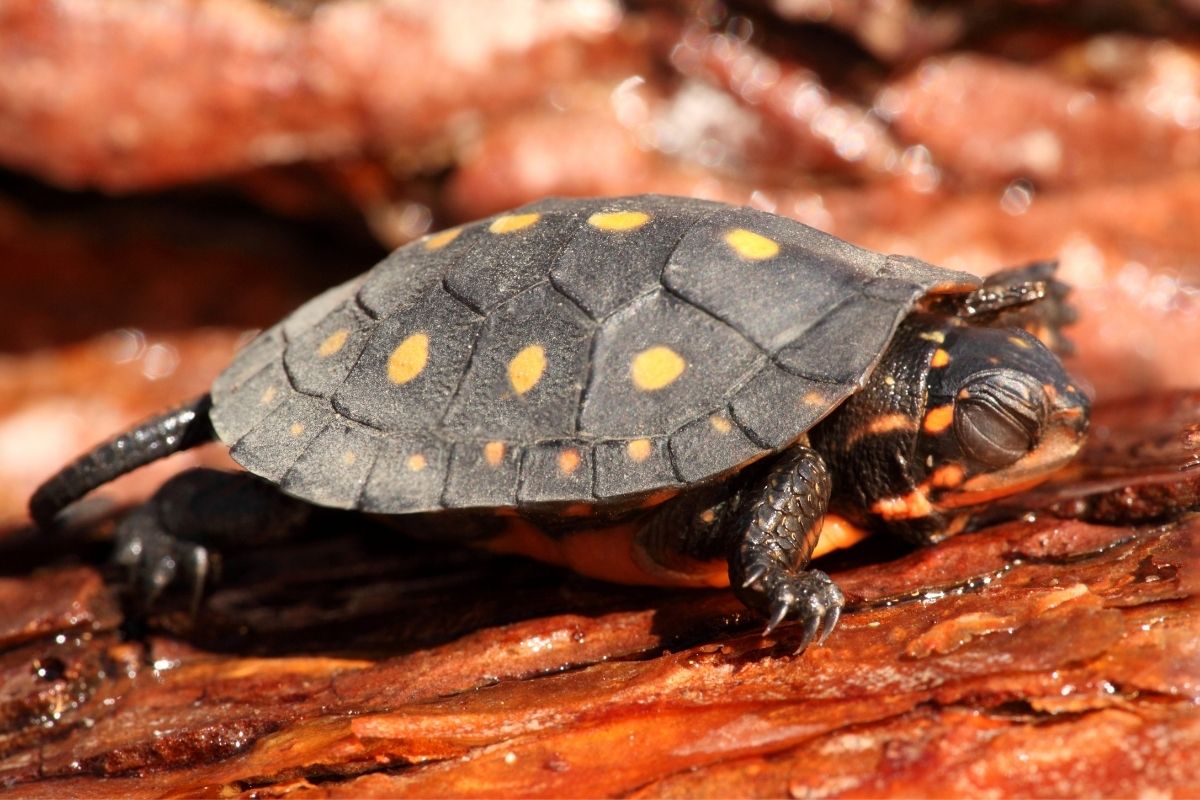
Although they are very popular as household pets, these reptiles are not easy to keep. Turtles require large amounts of space and food (they eat insects, small fish, and greens).
And these needs can vary from place to place. Especially in places where many of the turtles you can find are native, such as in Michigan, where there are many kinds of turtles roaming about.
So let’s have a look at some of these native turtle species found in Michigan!
Blanding’s Turtle

Starting off our list, we have Blanding’s turtle, named after the naturalist of the same name, William Blanding.
Whilst they are considered a species that is under threat in Michigan, they can still be found in the swampy and wetland areas that these turtles love and live in.
These little guys can live anywhere from 40 to 80 years old, depending on where it is found, or if they are kept in captivity. They can grow up to an average length of about 5 to 8 inches.
The males can sometimes weigh as much as 2 pounds, while females usually weigh around twice this amount, as, like many other reptile species, female turtles tend to be a little larger than their male counterparts.
As with other reptiles, they need to eat every couple of days for them to survive. It is also important to note that although these turtles do not need any special conditions to live in, they will prefer a warmer climate to a colder one.
So if you want to keep one of these guys at home, make sure your enclosure has a pretty good heating system!
If you see one out in nature, make sure to give them plenty of space, as they are known to bite. And, like many other turtle species, their beaks have a pretty sharp edge to them.
Common Map Turtle
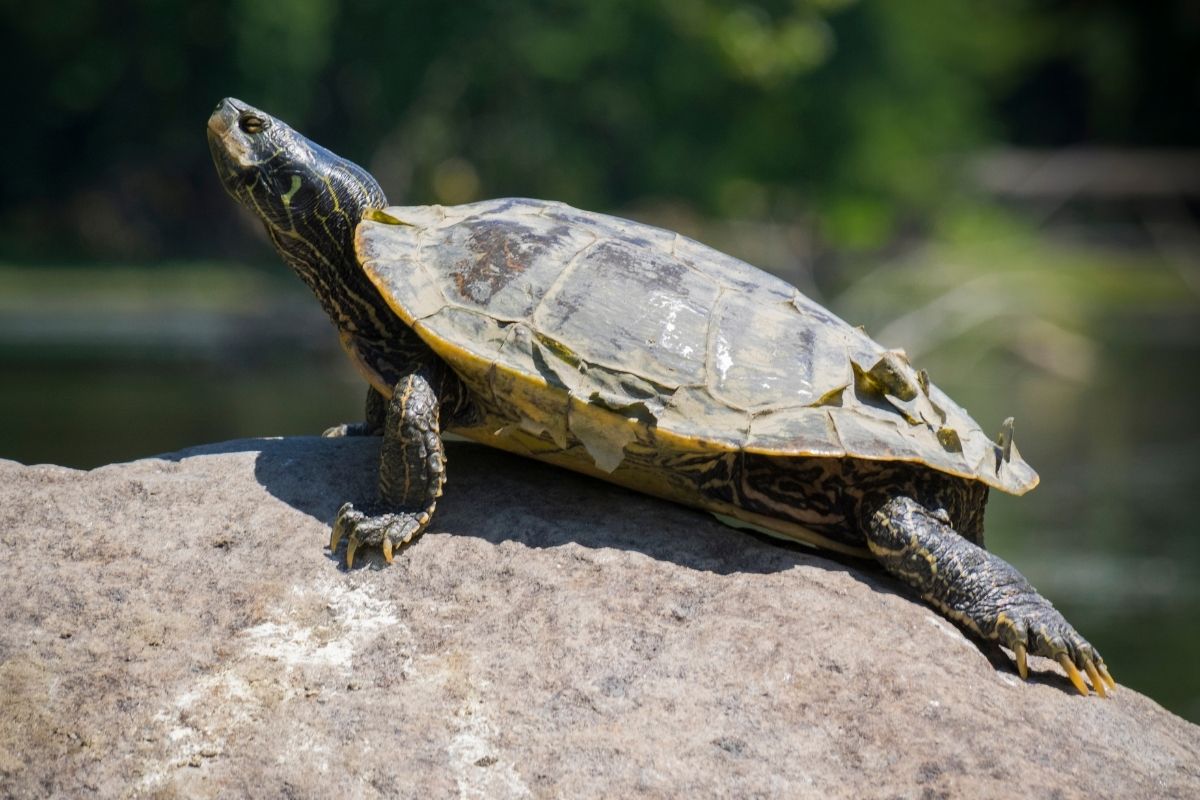
Up next, we have another classic little terrapin from this corner of the country, the Common Map Turtle!
This species gets its name from the unique patterns that tend to form along the outside of its shell.
Whilst they don’t initially bear any resemblance to maps on first inspection, many naturalists noted that the lines of the different segments of the upper shell did resemble the contours of natural features as they are shown on a map.
They can grow up to an impressive size of between 6 and 10 inches. As with most turtles, adult females tend to be bigger than their male counterparts and can reach lengths of about 12 inches.
As well as being great swimmers, they are also able to climb trees and even jump and hop. This enables them to use their hind legs to help propel themselves through the water.
With so many places for this species of turtle to live in Michigan, there is no shortage of places to find the Common Map Turtle.
However, the best way to spot one is by looking for them near the shores of lakes, rivers, and ponds, as being primarily aquatic creatures, these turtles will not often be found far away from water unless something is wrong.
If you do happen to come across one whilst you’re out walking, try not to disturb them, as they will often dive into the water when threatened.
Common Musk Turtle

Also known as the ‘stinkpot’ turtle, these smaller turtles are fairly common across all of Michigan.
Having dark, unremarkable shells, the best way to tell if a turtle is a musk turtle or not is to look at its head, as they have a somewhat flat nose when compared to the sharper edges that most turtles have on their beaks.
The Common Musk Turtle tends to stay close to the shoreline, preferring freshwater environments over saltwater ones. They can live in saltwater for short periods, but this is not recommended if you are keeping one of these shelled animals.
These guys tend not to grow very large, reaching a length of just under 5 inches long at most. Females tend to be slightly larger than their male counterparts, weighing in at around 1 pound each.
Like most turtles, musk turtles must eat every few days for them to remain healthy. If you see one out in the wild, make sure to let them be, as they may feel threatened if approached too closely.
The musk turtle gets its distinct name from the odor that it can excrete from its musk glands as a defense mechanism.
When threatened, they will release a chemical that is both horrible to smell and foul to taste. This is an effective strategy that works well against foxes, raccoons, skunks, and birds of prey.
Despite this, however, many people keep these little turtles as pets, despite the awful smell that can be released. You can keep a musk turtle safely indoors, however, they need access to freshwater.
Snapping Turtle
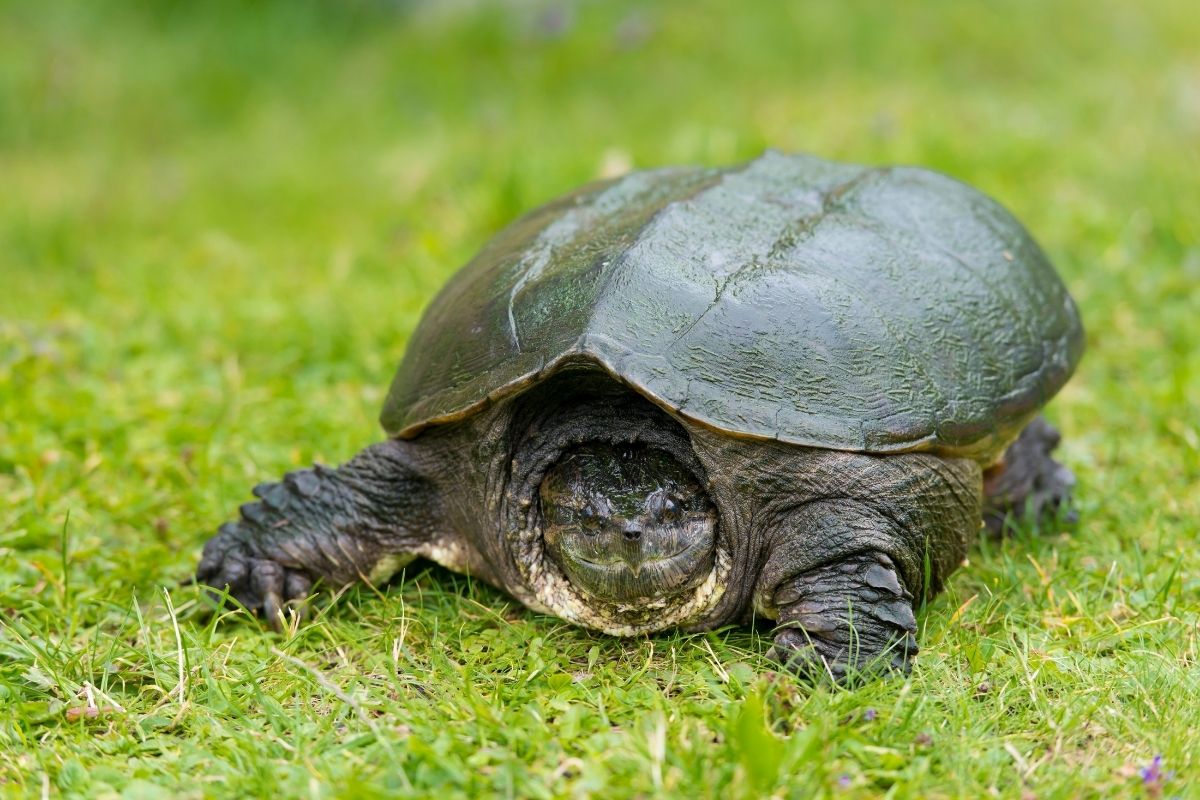
Probably one of the largest species of turtles that you will find in Michigan, the snapping turtle is an iconic animal that is known around the world for its incredible biting power and speed.
Whilst speed and turtles don’t seem like they should belong in the same sentence, their agility when it comes to their neck and jaw muscles is legendary, hence the name.
As we already mentioned, these guys can get quite big, growing to around 20 inches long. Adults of this species are very heavy too, with some reaching as much as 23 pounds on average!
As you would expect from such a powerful animal, snapping turtles are excellent swimmers and are not usually found far from water.
They prefer lakes and ponds over rivers due to their ability to breathe underwater. Although they can travel some distance over land, they are not capable of jumping as high as other species of turtle.
Snapping turtles are carnivorous creatures, feeding predominantly on fish, frogs, insects, crustaceans, worms, snakes, small mammals, and amphibians.
The easiest way to identify whether a turtle is a snapping turtle, aside from their larger size, is that their beaks are hooked, which helps catch prey when they are biting down on larger animals.
On the subject of biting, these turtles tend to be very aggressive to anything that attempts to come near them, so give them plenty of space if you happen to see one away from the water. And do not attempt to stroke them.
A snapping turtle can easily break your fingers with a single bite!
Eastern Box Turtle

This little guy has been an icon for decades, and he hasn’t changed his look too much since those early years. These turtles are typically about 4½-6 inches long, but there are some smaller individuals that you might find.
Box turtles are omnivores, eating mostly plants and bugs (especially ants), along with a variety of invertebrates like crayfish, snails, slugs, flies, beetles, spiders, and earthworms.
As we said earlier, box turtles only live in areas where there is lots of moisture available, especially if they are going to hibernate during the winter months.
They have to be fairly active throughout the year, though, as some box turtles are known to travel up to 50 meters in a single day to find food.
Interestingly enough, these turtles tend to prefer to spend time on land rather than water, making them very similar to tortoises in their lifestyle.
Like many other reptiles, box turtles are diurnal, meaning that they are active during the day. During the night, they will rest and hide in shallow water, usually in little bowls that they have scooped out themselves.
They are not territorial, so you won’t have to worry about fighting over territory with other box turtles. If you do encounter one, just avoid getting between them and their nesting area. These guys will protect their homes ferociously.
Box turtles can be pretty difficult to house, and most pet stores won’t let you bring one home unless you are a collector or scientist. If you do manage to acquire one, make sure you check out how to care for a pet box turtle first.
Painted Turtle

Up next, we have one of the most iconic species of pet turtle, the painted turtle.
Known for their distinct patterns that run down the sides of their head and body, these little critters have been a popular choice of pet for decades, both in the United States, as well as abroad.
As far as diet goes, painted turtles eat insects, fruit, and vegetables such as carrots and cucumber. They also feed on freshwater mollusks and fishes like carp, catfish, and perch.
These turtles are nocturnal by nature, spending their days hiding in crevices and caves under rocks or logs.
Like most turtles, painted turtles require plenty of sun exposure to help them properly thermoregulate, so make sure you keep them in a place that gets at least six hours of sunlight each day.
It is important to remember, however, that painted turtles are relatively easy to stress out and get sick when kept in small spaces, so make sure you give them adequate amounts of space as well.
If you decide to get a painted turtle, you should probably start with a younger individual. The older they get, the more likely they are to become stressed and aggressive.
This species prefers slow-moving waters due to its inability to swim quickly.
It also needs more shade than most other kinds of turtles because it spends most of its time hiding under logs, rocks, and debris when not basking in the sun.
Cleaning and maintaining painted turtles requires patience. They need to stay clean at all times, otherwise harmful bacteria could get inside them.
When cleaning, use soap and warm water, and never immerse their heads in the tub. If they are dirty, place them in a separate container to soak.
Eastern Spiny Softshell Turtle
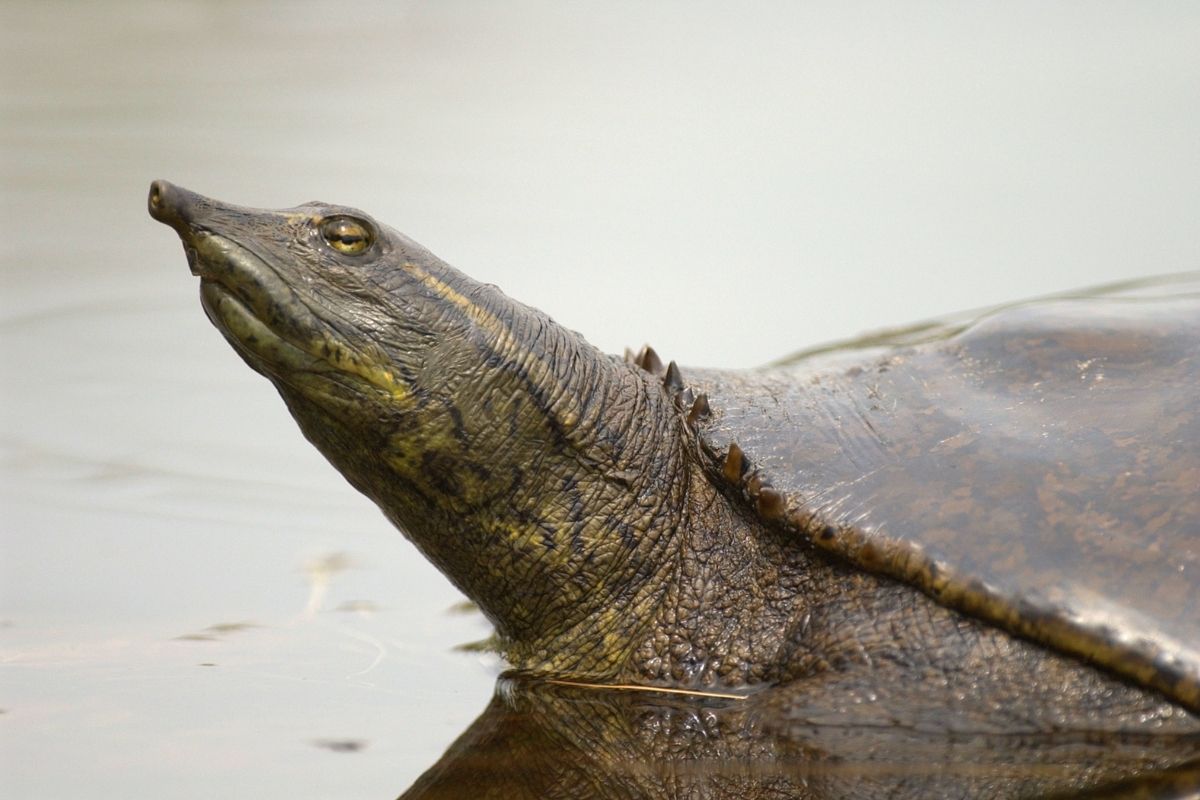
Next, we have a type of softshell sea turtle that has found a home in Michigan, the Eastern Spiny Softshell turtle.
Known most for the distinct leathery texture that this turtle has, these particular species tend to live in warmer climates than others, preferring milder temperatures and areas near bodies of fresh water.
Spiny soft-shelled turtles are omnivorous; meaning that they will eat plants, animals, and fungi alike.
Like the snapping turtle, these species are one of the biggest species that you’ll find in Michigan. Whilst the males will usually only grow to about 9 inches at most, females can grow as large as 20 inches in some cases!
These guys eat lots of different things: algae, shrimp, crabs, worms, snails, small fish like goldfish, and frogs. As mentioned earlier, they will eat insects as well, so if you find some dead ones lying around, toss them in there!
Red-Eared-Slider Turtle

Another popular breed of turtle that is often kept as a pet, the Red-Eared Slider is a semi-aquatic species of turtle that is usually found in the shallow banks and streams that run alongside and down lakes.
The Red-eared slider is similar to the eastern spiny softshell in many ways, but there are key differences between the two.
For one thing, red-eared sliders don’t have a leathery shell, which makes them much easier to handle, but can also make them noticeably heavier, despite the Eastern Softshell turtle being larger.
Spotted Turtle
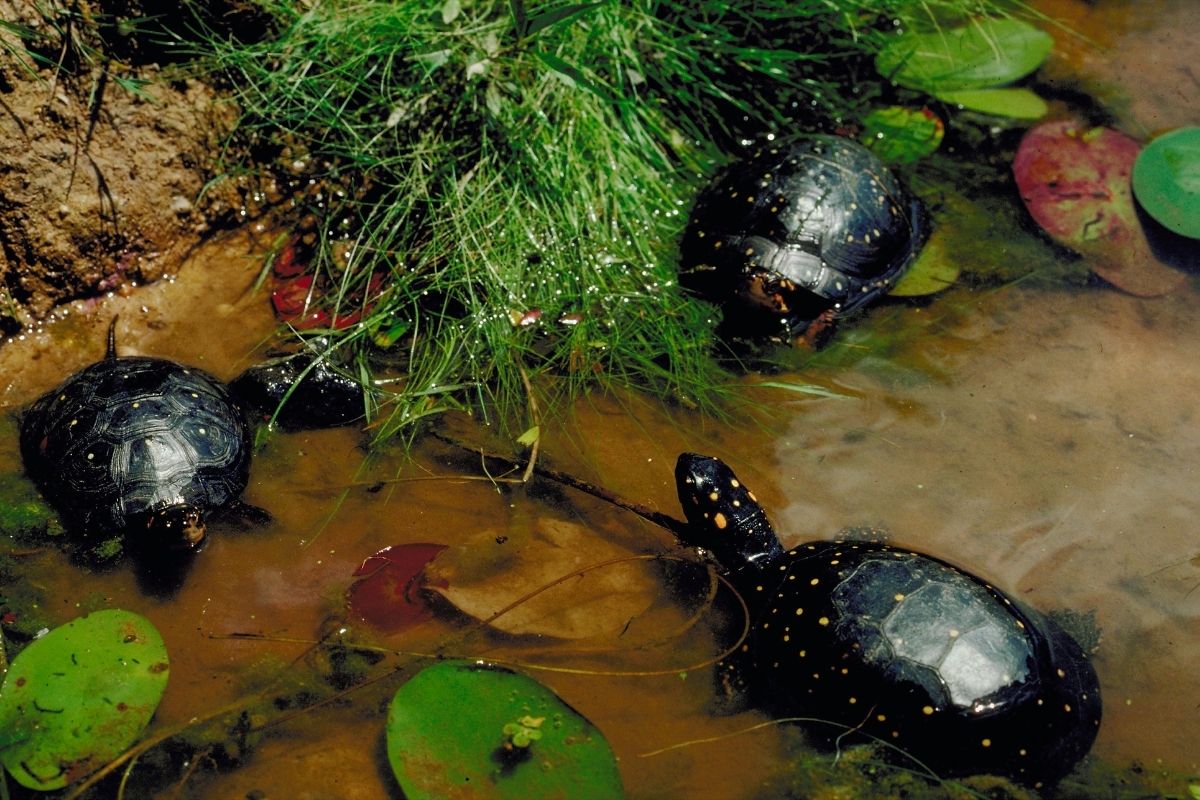
Who doesn’t love an adorable spotted turtle?
These little guys are quite common in Michigan, where they’re most commonly found along streams and rivers.
They tend to prefer very warm climates though, so if you want to try your hand at raising one, you may not be able to successfully raise them outside of the warmest parts of our state (like Northern Michigan).
They’re pretty big, too – up to 10 inches long and about 4 pounds or more. Their spots aren’t as noticeable as the spotted soft shells, but they still come in a variety of colors.
There’s no way to tell how old a caught turtle is by looking at it, but they tend to live anywhere from 5 years to 30 or even 40 years! That said, the older they are when captured, the harder it becomes to keep them alive.
Wood Turtle
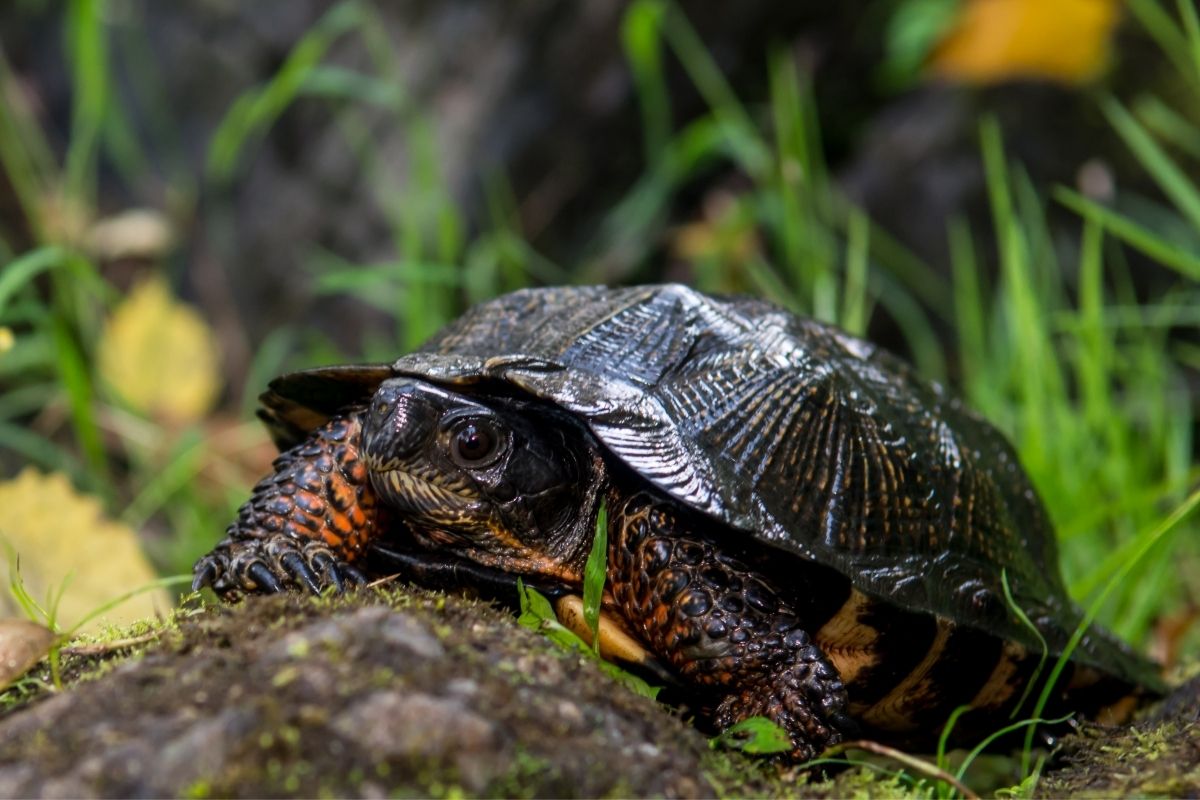
If you’ve ever seen a wood turtle while out walking in nature, then you know what we’re talking about. These guys are the smallest of turtles, with some reaching only 5 inches across. But these guys are worth keeping.
Most of them are semi-aquatic, so if you happen upon a lake, river, or pond, chances are good that you’ll see them scurrying about.
These turtles can live for over 50 years when raised in captivity, making them a very long-lived companion for people to own
Conclusion
There you have it. Michigan lakes and streams are practically brimming with turtles!
There are dozens of different kinds here, all of which have their personalities and quirks. If you’re interested in getting one, check out turtle farms, reptile stores, and pet shops to learn more about them.
